Microsoft Access is a database software
package. A database is an organized collection of records. Telephone
and address books are examples of paper databases. With Access, you can
create a computerized database. For example, you can use Access to
organize the students who attend a school, the courses they take, and
the instructors who teach them. After you create an Access database,
you can search it, manipulate it, and extract information from it.
This lesson introduces you to Access windows and teaches you how to
create a database.
You use windows to interact with Access. To begin, start Access 2007. You screen will look similar to the one shown here.
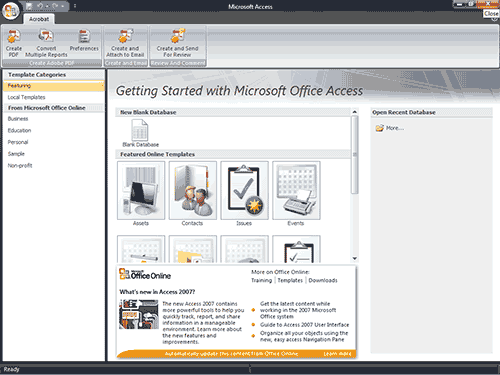
Understanding Security
It is possible for an Access database to contain malicious
code, such as a computer virus. Access has security settings that
disable code and display a security warning when you open a database.
If you know a database is trustworthy, you can perform the following
steps to enable it.
To enable a database:
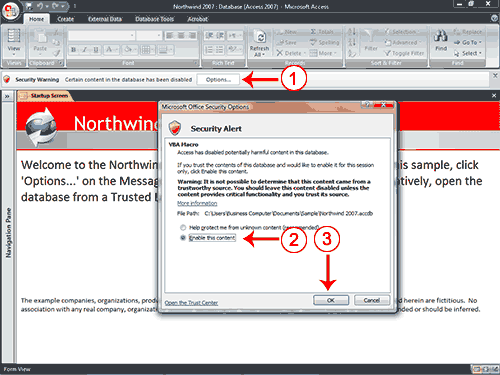
- Click the Options button. The Microsoft Office Security Options dialog box appears.
- Click Enable This Content.
The Ribbon

You use commands to tell Access what to do. In Access 2007,
you use the Ribbon to issue commands. The Ribbon is located near the top
of the Access window, below the Quick Access toolbar. At the top of
the Ribbon are several tabs; clicking a tab displays related command
groups. Within each group are related command buttons. You click buttons to issue commands or to access menus and dialog boxes. You may also find a dialog box launcher in the bottom-right corner of a group. When you click the dialog box launcher, a dialog box makes additional commands available.
Access Objects
To view or hide the objects on the Navigation pane:
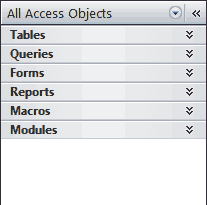
- You click the double down-arrows
 to view objects. The double down-arrows change to double up-arrows
to view objects. The double down-arrows change to double up-arrows  .
. - You click the double up-arrows
 to hide objects. The double up-arrows change to double down-arrows
to hide objects. The double up-arrows change to double down-arrows  .
.
As stated earlier, the Navigation pane stores the objects in
your database: tables, queries, forms, reports, macros, and modules.
Objects always display with an icon to the right. The icon tells you the
object type:  table,
table,  query,
query,  form,
form,  report,
report,  macro, and
macro, and  module.
module.
Objects |
|
| Tables | In Access, data is stored in tables. A table is a set of columns and rows, with each column referred to as a field. Each value in a field represents a single type of data. Each row of a table is referred to as a record. |
| Queries | You use queries to retrieve specific data from your database and to answer questions about your data. For example, you can use a query to find the names of the employees in your database who live in a particular state. |
| Forms | Forms give you the ability to choose the format and arrangement of fields. You can use a form to enter, edit, and display data. |
| Reports | Reports organize or summarize your data so you can print it or view it onscreen. You often use reports when you want to analyze your data or present your data to others. |
| Macros | Macros give you the ability to automate tasks. You can use a macro to add functionality to a form, report, or control. |
| Modules | Like macros, modules give you the ability to automate tasks and add functionality to a form, report, or control. Macros are created by choosing from a list of macro actions, whereas modules are written in Visual Basic for Applications. |
Understanding Tables
A table is a set of columns and rows. Each column is called a field. Within a table, each field must be given a name and no two fields can have the same name. Each value in a field represents a single category of data. For example, a table might have three fields: Last Name, First Name, and Phone Number. The table consists of three columns: one for last name, one for first name, and one for phone number. In every row of the table, the Last Name field contains the last name, the First Name field contains the first name, and the Phone Number field contains the phone number. Each row in a table is called a record.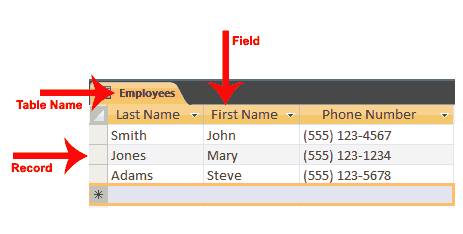
You can view an Access database as a collection of related tables. For example, in a database that contains tables for Employees, Students, and Courses, the Employees table lists the employees, the Students table lists students, and the Courses table lists the courses students can take.
After Access creates a blank database, it opens in Datasheet view and makes available the tools you need to create a table. Datasheet view displays a table as a set of columns and rows. When you view a blank database for the first time in Datasheet view, you see a column named ID. This column is by default the primary key field.
A primary key is a field or combination of fields that uniquely identify each record in a table. No two records in a table should have the same values in every field. For example, the following should not occur in a table.
| Last Name | First Name | City |
| Smith | John | Jonestown |
| Smith | John | Jonestown |
| ID | Last Name | First Name | City |
| 1 | Smith | John | Jonestown |
| 2 | Smith | John | Jonestown |
When you save your table for the first time, Access gives you the opportunity to name your table. Each table name must be unique; hence, two tables in the same database cannot have the same name. The table name should describe the data in the table; can consist of letters, numbers, and spaces; and can be up to 64 characters long. When choosing a table name, try to keep it short.
You can save a table by clicking the Save button on the Quick Access toolbar or by right-clicking the Tables tab and then choosing Save from the menu that appears.
To add fields to a table:
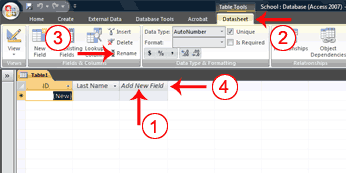
- Click the Add New Field column label.
- Activate the Datasheet tab.
- Click Rename in the Fields & Columns group.
- Type the field name.
- Press Enter. Access creates the field.
- Type the next field name. Access creates the field. Continue until you have created all of the fields in your table.
- Press Enter without entering a field name to end your entries.
- Right-click the Add New Field column label. A menu appears.
- Click Rename Column.
- Type the field name.
- Press Enter. Access creates the field.
- Type the next field name. Access creates the field. Continue until you have created all of the fields in your table.
No comments:
Post a Comment